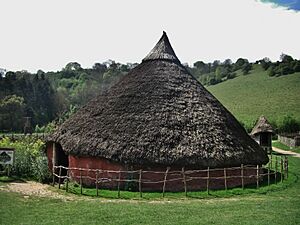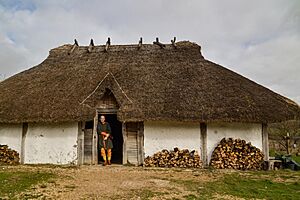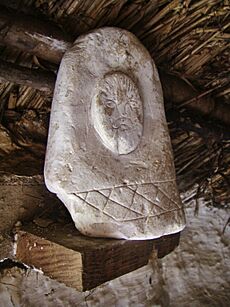Butser Ancient Farm facts for kids

Butser Ancient Farm's reconstructed Iron Age village.
|
|
| Lua error in Module:Location_map at line 420: attempt to index field 'wikibase' (a nil value). | |
| Established | 1970 |
|---|---|
| Location | Windmill Hill, Hampshire |
| Type | Archaeological open-air museum |
Butser Ancient Farm is a special place near Petersfield in Hampshire, southern England. It's like a living museum where you can see and learn about ancient buildings. Here, experts rebuild homes from the Stone Age, Bronze Age, Iron Age, Roman times, and early Saxon period.
This farm is not just for visitors; it's also a place for experimental archaeology. This means archaeologists try out old building methods and farming techniques. They learn how people lived and worked in Britain from about 400 BCE to 400 CE. This period includes the Late British Iron Age and Roman Britain.
The farm was started in 1970 by the Council for British Archaeology. In 1972, an expert named Peter J. Reynolds became its director. The farm moved a couple of times and is now located on the slopes of Windmill Hill, Hampshire.
Butser Ancient Farm is open to the public and hosts many events. An archaeologist named Mick Aston once said that the farm's work changed how we imagine Iron Age settlements. It really helped us understand how people lived long ago!
Contents
What is Butser Ancient Farm?
Butser Ancient Farm is an archaeological open-air museum. This means it's a museum that's mostly outdoors. It shows us what life was like in ancient Britain. You can see full-size copies of old buildings.
The farm is also a site for experimental archaeology. This is when archaeologists try to recreate things from the past. They might build a house using only ancient tools. Or they might grow crops the way people did thousands of years ago. This helps them understand how ancient people lived and solved problems.
A Look at Butser's History
Butser Ancient Farm began in 1970. It was started by the Council for British Archaeology. A key person in its creation was archaeologist Collin Bowen. In 1972, Peter J. Reynolds, an expert in experimental archaeology, became the director.
The farm was first located at Little Butser, near Butser Hill. This area had once been home to a Bronze and Iron Age farm. In 1976, a second site opened. It was called the Ancient Farm Demonstration Area (AFDA). This new area was mainly for visitors and school groups. It helped keep the main farm quiet for important archaeological experiments. The first Butser Farm site closed in 1989.
In 1991, the project moved to its current location. This is at Bascomb Copse on Windmill Hill, Hampshire. It's about 5 kilometers from the original site.
After Peter Reynolds passed away in 2001, his partner, Christine Shaw, managed the farm. She helped finish a Roman building project. This was a full-size copy of a Roman villa wing. It was even filmed for a TV series!
Since 2006, a team led by Simon Jay and Maureen Page has run the farm. They continue the important work of Butser Ancient Farm. Around 2006, one of the large roundhouses needed rebuilding. This gave the team a chance to use new information from archaeological digs. A new visitor center was added in 2013.
Exploring the Ancient Buildings
Butser Ancient Farm has many different types of ancient homes. Each one is built based on real archaeological discoveries.
Stone Age Homes
The Stone Age area has two buildings. They are based on discoveries from Durrington Walls near Stonehenge. These homes are made of wattle and daub (woven branches covered in mud) and have thatched roofs. One house even has furniture like what archaeologists found.
In 2019, work started on the early Neolithic Horton House. This house is based on findings from Horton, Berkshire. It uses Scots Pine, ash, and hazel wood. The roof is made of reed thatch. One side of the house has a wattle and daub wall, and the other has split oak planks.
Bronze Age Home
In 2021, the farm started building its first Bronze Age house. This house is based on discoveries from Dunch Hill on Salisbury Plain. This project worked with Operation Nightingale. This group helps military personnel and veterans by involving them in archaeology. The house was finished in October 2021.
Iron Age Roundhouses
Inside the Iron Age area, you can find six different roundhouses.
The biggest one is the Little Woodbury roundhouse. It is about 14.5 meters across. To build it, they used about 12 tons of oak for the frame. They also used 4 tons of ash and elder for the roof, 7 tons of thatch, and 1.5 tons of hazel for the walls. About 20 tons of daub (mud mixture) were used too!
Two houses are based on findings from Danebury Iron Age Hillfort. One is built with willow woven between hazel stakes. The other has oak plank walls. This house shows what Iron Age furniture might have looked like.
The Moel Y Gerddi Roundhouse is from Harlech in North Wales. It's built in a similar style to the Little Woodbury house. This house is special because it has a back door! In 2009, the inside posts needed replacing. They managed to do this without taking the whole house apart.
Two other houses are based on the Glastonbury Lake Village. These were built to be very light. This is because the original houses were on marshy ground. They have thin willow walls and reed thatch roofs.
The Iron Age area also has grain pits, an Iron Age toilet, and bread ovens.
Roman Villa
You can also see a reconstructed Roman villa. This building is based on a wing of the Sparsholt Roman Villa. It even has a working hypocaust system. This was an ancient Roman heating system that warmed floors and walls.
In 2017-2018, the villa was updated. The walls were repainted with colors and patterns found on old plaster. A copy of a mosaic floor was also added. This mosaic used over 120,000 tiny pieces and took 1000 hours to make! The villa is also furnished with Roman-style items.
Saxon Houses
There are two houses based on discoveries from the nearby Chalton Saxon Village. Chalton A2 was built in 2017. It's made mostly of English oak, sweet chestnut, and hazel wood. These materials came from local woodlands. The roof is made of woven panels with wheat straw thatch. No nails or screws were used in the main structure. The beams are held together with special wooden pegs called trunnels.
Chalton A1 is still being built. It will have different types of walls and a gable end roof. There's also a small Saxon workshop. It shows how Saxon people joined timbers and how they made shingle roofs.
Learning Through Experimental Archaeology
Peter Reynolds, the first director of Butser Ancient Farm, was very important in developing experimental archaeology. Since 1972, the farm has done a lot of research. It focuses on ancient farming, homes, and daily life.
Today, studying buildings is a big part of the farm's research. Every building you see is the result of an experiment. Archaeologists test ideas about how ancient buildings were made. They look at things like roof shapes, different thatching materials, and how to use wattle and daub, planks, or turf.
The farm started by building Late Iron Age structures. Now, their research includes buildings from the Mesolithic, Neolithic, Bronze Age, Iron Age, Roman, and early medieval periods.
Butser on Screen
Butser Ancient Farm has been a filming location for many TV shows and movies.
In 1986, the Doctor Who episode "The Mysterious Planet" was filmed here. The farm was also featured in a 2005 BBC Television documentary series called What the Ancients Did for Us. This show explored ideas and inventions from ancient Britons.
You might have also seen Butser in other archaeological shows. These include Mystic Britain, Digging for Britain, and Britain’s Pompeii - A Village Lost in Time with Alice Roberts.
The farm has also appeared in feature films and TV series. These include Horrible Histories: The Movie – Rotten Romans, Britannia, Arthur and Merlin, The Four Warriors, and Gladiatress.
In 2021, Butser Ancient Farm launched "Butser Plus." This is a platform with documentaries about their experimental archaeology projects.
See Also






